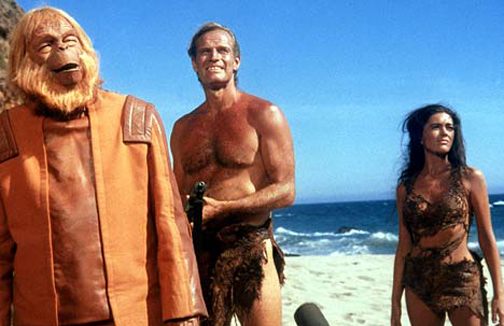Action! Thrills! Mystery! The cinema of yesteryear never dies! Whether you’re running from the 50 foot woman or exploring the final frontiers on the U.S.S. Enterprise, there’ll always be a case to investigate, a monstrous villain to defeat and heroics to be done! Join Mason Horsley as he takes you on a journey across the stars in his review of Nathan Juran’s ‘First Men In The Moon’! In Dynamation! Then, follow Daniel Fagan as he escorts you through a world gone mad, where evolution is a bitter joke, in his review of Franklin J. Schaffner’s ‘Planet Of The Apes’! In Colour!
First Men In The Moon (1964) dir. Nathan Juran – Review By Mason Horsley
In 1969, NASA launched Apollo 11, flying Neil Armstrong, Buzz Aldrin and Micheal Collins to the Moon, but only 5 years earlier, a film was released that would reimagine what we did and didn’t know about that tiny white dot in the sky. We’ve all heard different stories like the Moon landing was faked in a studio, ‘Moonfall’ imagined the Moon as an operating system for an ancient civilisation, ‘Apollo 18’’s virus horror film, but what about H.G. Wells’s fantasy? A subterranean city of aliens discovered by a trio of Brits in the year 1899? Strap in, we’re going full Harryhausen!
‘First Men In The Moon’ is a 1964 sci-fi film directed by Nathan Juran with visual effects done by the legendary animator Ray Harryhausen, the man behind “dynamation”, which most of his films, including ‘First Men’ used. “Dynamation” would be employed by filming models against a projected screen, an early predecessor to green-screening. In ‘First Men’, the combination of dynamation and stop-motion for the alien creatures makes for an incredibly charming blast to the past.
When the first space shuttle lands on the Moon, its astronauts are stunned to discover a flag of the Union Jack and a declaration of the Moon’s British claiming dated to 1899. The U.N. track down Arnold Bedford, the husband of the declaration’s signatory and he begins to tell the tale of the first expedition to the Moon. When Arnold invests all his money in Joseph Cavor’s invention, ‘Cavorite’, an anti-gravity substance, the two hatch a plan to land on the Moon to harvest its materials for sale on Earth, but when they find themselves taken hostage by aliens with Bedford’s fiancée, they must find figure out a way to repair their ship and get off the rock before they find themselves in mortal danger.
Edward Judd and Lionel Jeffries play Bedford and Cavor respectively and have great on-screen chemistry, with Judd being a great straight man to Jeffries’s flamboyance. When the two clash, it felt as if I was watching Graham Chapman and Eric Idle in ‘Monty Python Go To The Moon’. The two quickly turn this into a sci-fi comedy to match ‘Galaxy Quest’ and ‘Mars Attacks!’ Martha Hyer plays Katherine Callender, Bedford’s fiancee, perfectly personifying the stereotypical damsel in distress, no idea what’s going on but she has a few words to say about it. Unfortunately, despite the level of significance flung onto her character, Callender doesn’t have much to do here other than get kidnapped, get rescued and escape. I believe Nathan Juran did an amazing job at directing, this film could have been a horror film, focusing on our fear of the unknown, but instead, he decided to turn this into a film all the family can watch. The comedy is so child-friendly, I’m actually confused why my copy came as a double-feature with ‘10,000 Miles To Earth’, a film about an alien from Venus going full Godzilla!
Of course, the main attraction is the special-effected aliens, it’s always a treat to see how they were pushing visuals in film even in the 50s and 60s. The most prominent alien you’ll see will no doubt be the ‘Moon Cow’, a giant pincered beast that looks more like a caterpillar-centipede. I found a lot of charm in the alien X-ray of Callender, no doubt, Harryhausen recycling his work from ‘Jason And The Argonauts’. Nonetheless, I believe every true cinema lover needs to watch one film with Harryhausen’s monster animated magic, so go out and grab a copy and start with this one!
Mason’s Top 3 Reasons To See ‘First Men In The Moon’
- Ray Harryhausen’s masterful animations and alien creations
- A comedy duo that leads us with Willy Wonka energy on an exciting odyssey to the moon!
- A secret alien society on the moon with a culture that I, personally, would die to examine. What’s their religion? What do they survive on? What the hell did the space cows evolve from?!
Planet of the Apes (1968) dir. Franklin J. Schaffner – Review By Daniel Fagan
“Does man, that marvel of the universe, that glorious paradox who sent me to the stars, still make war against his brother? Keep his neighbour’s children starving?”
It has been over fifty since Schaffner’s Planet of the Apes first released in theatres in 1968. In that time there has been four sequels, and two attempts to revive the series in the twenty-first century. The second revival, beginning with 2011’s Rise of the Planet of the Apes pushed the boundaries of technology in film to its startlingly beautiful limits and continues to do so with the release of the fourth entry earlier this year. Along with the films, there have also been two TV shows and multiple comic books both expanding the histories of the world and attempting to subtly bridge the stories of the original series and the newer works with varying degrees of success. The well of the Planet of the Apes runs deep and shows no sign of drying up.
One of the greatest strengths of science fiction is its capacity to speak universal truths through time. The scathing indictment of US cold war nationalism spurred by the weaponisation of religion unfortunately burns just as bright today. While the newer films have largely moved on to address more pressing themes of today, undertones of Michael Wilson and Rod Serling’s original screenplay remain.
A thing about the ‘Apes’ films, at least the first batch of five is they rarely push their themes and ideas as far as they can. In some cases, detrimentally, as with 1970’s Beneath the Planet of the Apes, but in others, the perfect balance is struck. Planet of the Apes brilliantly rides this line between rollicking action adventure, and astute political critique thanks in no small part to the all-star creative team behind the camera.
Beginning with a mediocre novel by French author Pierre Boulle, a WWII spy-turned-author best known for novel-turned-David Lean epic in 1957, The Bridge Over the River Kwai, Planet of the Apes (novel) is very different from its film counterpart. At worst it’s boring and at best it’s a lukewarm critique of twentieth-century consumerism. Fortunately, once Fox was convinced to greenlight a film adaptation of the work, The Twilight Zone creator Rod Serling was given the reigns to pen a screenplay. While Serling’s screenplay was heavily re-written prior to the beginning of filming, enough of his original ideas, including what is possibly the most significant and memorable ending of all time remained and he retained a ‘Written by’ credit. The writer brought in to re-write Serling’s script was blacklisted writer Michael Wilson, who was no stranger to adapting Boulle’s work, penning the script for The Bridge on the River Kwai for which he won his second Academy Award. Wilson also wrote the screenplay for Lean’s other masterpiece Lawrence of Arabia. Wilson retained most of the structure of Serling’s original work but made some dialogue changes and altered some elements to work within the small budget.
The most prominent member of the behind-the-scenes production I must praise is director Franklin J. Schaffner who was one of the key directors of the early New Hollywood movement with key films such as Patton (1970) and Papillon (1973). He is a director who should be a household name but was unfortunately lost to time. His direction of ‘Apes’ is stellar and the way he is able to film what should be totally ridiculous and treat it with utmost sincerity (most of the time) is what allows ‘Apes’ to work.
An additional reason as to why Planet of the Apes works is the make-up and prosthetics of the apes. John Chambers’ revolutionary work won him an Honorary Academy Award and made him the go-to make-up designer in Hollywood for most of the twentieth century, with most of his work going uncredited until after his death in 2001.
I would be remiss to not mention the definitive star of the film. If the make-up and realistic apes were the thing drawing people to the film, Charlton Heston’s George Taylor is why they stayed. Heston is magnetic and carries the film effortlessly. If there is one thing to take from this review, and I do hope you take more than one, it’s that you must watch more films starring Charlton Heston. He mastered the role of the archetypal hero and always made them his own. When Heston is on screen, in any of his roles, not just in ‘Apes’ it is impossible to imagine anyone else but him.
Watch Planet of the Apes, even if you know the twist (and to be honest, I’d be surprised if you didn’t) it is worthwhile. It’s a movie with lots to say but its philosophy is digestible. There are innumerable memorable characters from Heston’s Taylor, Roddy McDowall as Cornelius, Kim Hunter as Zira and Maurice Evans as Dr. Zaius. The world is strange, but familiar and you will be desperate to find out what happens next, even if the first of the sequels is far lesser than the others. Planet of the Apes is a movie that knows exactly what it is, and it’s comfortable in its own skin. It’s an action sci-fi movie, critical of 1960’s US policy and a movie where a trio of orangutans pose seeing no evil, hearing no evil and speaking no evil. Then a character will say one of the most intense lines in the history of film.
“Beware the beast Man, for he is the Devil’s pawn. Alone among God’s primates, he kills for sport or lust or greed. Yea, he will murder his brother to possess his brother’s land. Let him not breed in great numbers, for he will make a desert of his home and yours. Shun him; drive him back into his jungle lair, for he is the harbinger of death.”
Planet of the Apes is a great time, watch it on the biggest screen you can. Let the moments that have entered the cultural zeitgeist wash over you and the smaller moments shock you, but above all have a good time, this is a movie about talking apes after all.
Image Credit: Rogerebert.com

Mason Horsley is a graduate of UOW with a Bachelor’s degree in Creative Arts, majoring in Creative Writing and minoring in Theatre. He hopes to write and direct a feature film and has been working on screenplays since he was 17. He writes film reviews for the Tertangala and works on his latest project ‘The Last Film’ while working a full-time job at a fish market. Mason despises reviewing films he dislikes and because of this, every review he writes acts as a recommendation.




